
Have you ever wondered how much is a dime worth today or whether those old dimes you have can fetch more value than 10 cents?
This is not just due to the fact that they are composed of silver but for a variety of other reasons, which will be discussed below. One of the reasons that are rare or exhibiting manufacturing error is what really matters.
Imagine the excitement when you find a tiny piece of treasure in your attic or a pocket.
Collectors are especially drawn to rare dimes with few mintages, special attributes, or mint inaccuracies. In fact, considerations such as the condition of the dime, the year it was minted, any mint marks, and its history plays a vital role in determining its value.
So, if you want to build a dime collection with significant historical and monetary value, these aspects and inspections will undoubtedly help you.
Let's explore how much is a dime worth, the most valuable Roosevelt dimes, and so on in a simple breakdown.
Have you ever wondered how much is a dime worth today or whether those old dimes you have can fetch more value than 10 cents?
This is not just due to the fact that they are composed of silver but for a variety of other reasons, which will be discussed below. One of the reasons that are rare or exhibiting manufacturing error is what really matters.
Imagine the excitement when you find a tiny piece of treasure in your attic or a pocket.
Collectors are especially drawn to rare dimes with few mintages, special attributes, or mint inaccuracies. In fact, considerations such as the condition of the dime, the year it was minted, any mint marks, and its history plays a vital role in determining its value.
So, if you want to build a dime collection with significant historical and monetary value, these aspects and inspections will undoubtedly help you.
Let's explore how much is a dime worth, the most valuable Roosevelt dimes, and so on in a simple breakdown.
As they say, dimes make dollars.
However, some dimes have a higher value than a few bucks. You must be wondering about what numismatic value is. The amount a seller gets for selling a collectible coin is known as its numismatic value.
The coin's quality, rarity, and demand all affect its value. The numismatic value plays a major role in determining how much is a dime worth.
View the silver dime sold price chart below before we delve further into the coin's worth.
| PRODUCT | SOLD FOR ($) | PRODUCT (Similar year, higher grade) | SOLD FOR ($) |
|---|---|---|---|
| 1936 MS-63 | $25 | 1936 - D PCGS MS68 FB | $9,000 |
| 1936 PR68 (Proof Mercury Dime) | $29,000 | ||
| 1936 - S MS68 | $15,000 | ||
| 1941-D PCGS MS64 FB DDO and DDR | $195 | 1941-D MS68 FB DDO (Double Die Obverse) | $3,000 |
| 1941 PCGS MS68 FB (Tonning) | $7,000 | ||
| 1941 PF69 (Tonning) | $11,000 | ||
| 1941 S PCGS MS68 FB | $17,000 | ||
| 1940 PCGS MS68+ FB CAC (Tonning) | $9,900 | ||
| 194 S MS61 | $10 | 1940 S PCGS MS68 FB | $9,000 |
| 1940 PF 69 NGC (Toning - Rainbow) | $11,700 |
The US dime's coin production generally features coin values not exceeding their face value after 1964.
Whereas the true value of coins produced prior to that period usually surpasses their nominal value. What is the tale?
Before the enactment of the Coinage Act 1965, all coins minted were silver. This Act substituted silver dimes with copper nickel.
Besides having misprinted dates, dimes are also valuable due to other errors discovered on them. Another factor is to decide whether a dime is lightly or highly worn, circulated, or uncirculated based on its condition.
The above chart shows this clearly, too: circulated dimes aren’t valued as high as uncirculated dimes with higher mint state grades.
The value of dimes can be an exciting pursuit for collectors and enthusiasts. The most crucial factors in determining the value of a dime are its condition and grading.
Several factors determine the coin's grade, including
Any coin's precise value depends on evaluating its state. When grading dimes, sections of the coin are evaluated for wear. A precise "grade" is given based on how much detail is still missing.
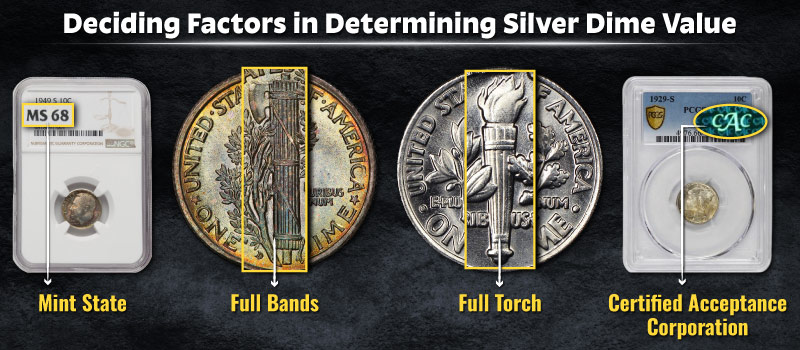
Coins in MS67, 68, and 69 grades are valued more than coins in lower grades because they are considered top-notch specimens that have never been in the market. Grades typically denote a rich color and are nearly flawless.
NGC/PCGS provides a numerical grade that denotes an overall issue-free coin. Some coins may have more in-depth descriptive information about their appearance and condition.
NGC/PCGS issuers assign the coins a range of designations called "Strike Characters", like FB (full band) and FT (full torch). Because of these glaring features, it stands out among other coins of the same denomination.
The Mercury dime's reverse has a fasces, a collection of rods joined at the top, middle, and bottom by bands. The two central bands on the middle of the coin must display complete separation, with a settled area between them, to be qualified for the NGC's Full Bands designation.
The reverse of the Roosevelt dime, which substituted the Mercury dime, has a torch with bands at the top and bottom. Both of these band pairs must exhibit complete separation, and the vertical lines of the torch must be clearly defined in order for the NGC to be designated as having a Full Torch.
Established in 2007, the Certified Acceptance Corporation (CAC) is an independent grading agency. The CAC wants to give coin collectors even more assurance about the caliber and legitimacy of the coins they own that have been graded by giving the stickers.
Green stickers, which can increase a coin's value by up to 92%, are applied to coins that are thought to be higher end for their grade.
Ungraded coins that would typically receive a green sticker in the next highest grade are awarded gold stickers, which often have an average value 90% higher than PCGS or NGC-graded coins that have already been assigned the next highest grade.
Applying the grading system established by reputable grading services such as the Numismatic Guaranty Corporation (NGC) or the Professional Coin Grading Service (PCGS), evaluate the dime's condition. Better-looking coins typically fetch higher prices. Seek for minimal wear or damage, luster, and sharp details.
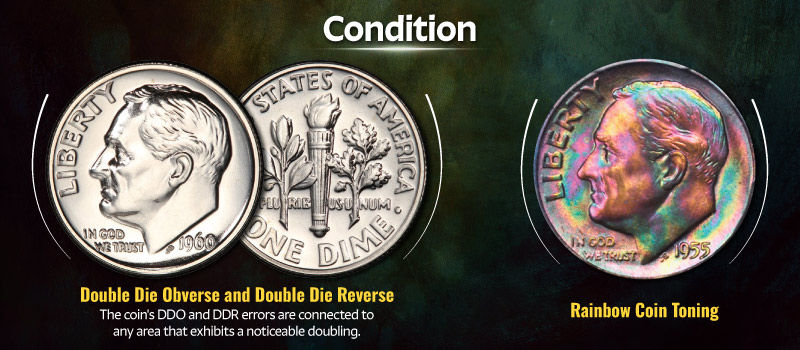
The primary cause of double-die coins is a malfunctioning hub that produces numerous dies needed for the minting procedure. Collectors categorize double-die coins as OMM (over mint mark), DDR (double die reverse), and DDO (double-die obverse coins).
When a date or part of a date is punched over another date or mint mark, the over-mint mark is produced. These coins are typically limited to those that were minted in the early years.
The coin's DDO and DDR errors are connected to any area that exhibits a noticeable doubling. Depending on their rarity, condition, and doubling, doubled die errors may be valuable. Coins with a completely doubled image typically fetch a higher price than ones with only a partial doubling.
Tarnishing is the more popular term for toning. This involves discoloration of the metal due to chemical reactions that take place over time. Coin toning is mostly the result of sulfur or oxygen reacting with the metal. The metal can take on a variety of hues, including blue, bright red, and green.
Rainbow-toning Coins can exhibit if their chemical reaction produces a visually striking rainbow-like effect.
Toning, when done correctly, can give a coin an additional layer of eye appeal that many coin collectors look for in their collections. Because the coin is unique, collectors will pay more than the graded value of the same untoned coin.
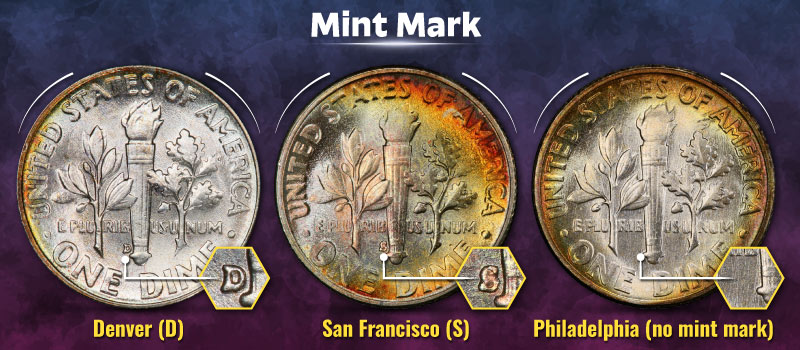
Mint marks, which include "S" for San Francisco, "D" for Denver, and "P" for Philadelphia, identify the precise mint from which the coin was made. Some dates and
mint marks are more valuable than others because they have distinctive features or smaller mintages.
The table below lists the mint marks and the dates they were used for each of the Mint's past and present facilities.
| Mint Branch | Mint Mark | Years Mark Used |
|---|---|---|
| Carson City (NV) | CC | 1870-1893 |
| Charlotte (NC) | C | 1838-1861 |
| Dahlonega (GA) | D | 1838-1861 |
| Denver (CO) | D | 1906-Present |
| New Orleans (LA) | O | 1838-1861, 1879-1909 |
| Philadelphia (PA) | P | 1942-45, 1979-Present |
| San Francisco (CA) | S | 1854-1955, 1968-Present |
| West Point (NY) | W | 1984-Present |
To illustrate the main supply and demand law, the market for rare date silver dimes is the best example of this. Collectors are the ones who want these coins, and there are an extremely small number of them in the market, thus making them worth a lot.
Dimes with a face value of 10 cents consisting of rare dates, errors, and special features, including FB, FT, DDO, and DDR dies, can reach really high values.
These rare silver dimes are in very high demand, particularly those in a Mint State grading of more than 65 and uncirculated condition. Coin collectors await sales of such coins at auctions and are ready to pay top dollar for them.
Currently, a silver dime weighs 2.5 grams and contains approximately 0.0723 troy ounces of silver. It contains 90% silver. The collector's worth frequently exceeds the baseline of silver price. For instance, because of its scarcity, a 1916-D Mercury Dime in superb condition can sell for thousands of dollars.
Historically, American dimes were primarily struck in silver between 1796 and 1964. Since the price of silver increased, the silver content of post-1964 dimes was removed, and they are now made of a copper-nickel alloy. But since then, collectors' editions of silver have been released in special quantities.
The following series can be used to group the years that silver dimes were issued:
The Draped Bust Dimes features Lady Liberty with flowing hair, representing the ideals of the early nation. In contrast, the Roosevelt Dimes, which marked the end of the silver dime era in 1964, symbolize a time of important socio-political transformation in America.
Naturally, the dime has been in circulation in US territories for a long time. Numerous examples have been minted, both in and out of circulation. Certain valuable coins have a higher chance of being in use.
Rare coins valued at millions of dollars are available. The most valuable pennies remain in perfect condition over time.
The list of the most valuable dimes in American history is provided below.
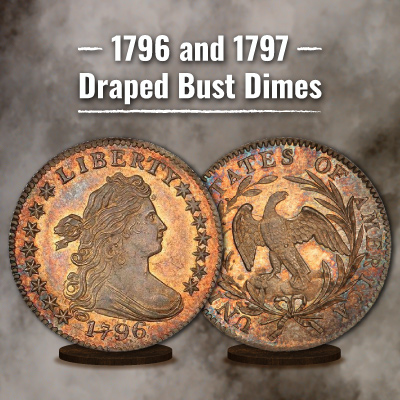
1796 and 1797 Draped Bust Dimes are one of the valuables from that early era of United States Mint federal coin production. The Draped Bust dime from 1796 is incredibly valuable. This is due to the coin's genuine rarity and the fact that it commemorates the year the denomination was first struck.
There were only 22,135 made, and very few of those have survived.
A dime from 1796 is valued at approximately $2,600, even in the severely worn Good-4 grade.
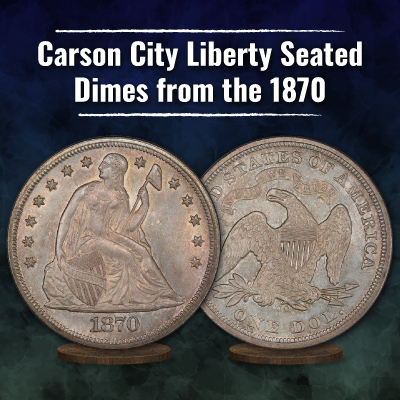
Any coin bearing the mintmark "CC" seems to naturally catch the interest of many collectors these days. It stated that the coin was struck at the Nevadan Carson City Mint. Today's collectors value all coins with the mintmark "CC" as rare.
Extremely uncommon are the Carson City Seated Liberty dimes minted between 1871 and 1874. Each coin has at least four figures and is rated Good-4. With a mintage of 12,400 pieces, the 1873-CC is the most valuable of these dimes; collectors can currently only find one surviving example.
One of its most recent transactions brought in $1,840,000 for the mint-condition 1873-CC dime!
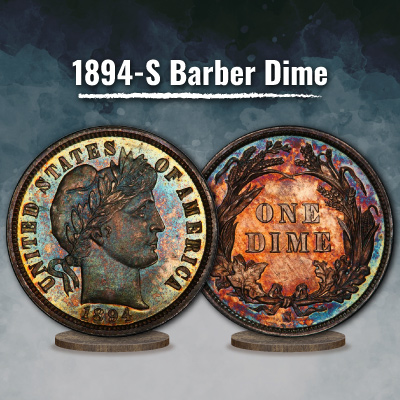
According to PCGS Coin Trackers, there are currently just nine known examples of the 1894-S Barber dime, making it one of the rarest US coins. In January 2016, one sold for $1,997,500 at auction.
The dime has "One Dime" stamped in the center of a wreath on the back, with a profile of Lady Liberty on the front. Despite being a proof coin, a few were put into circulation; one appeared at the Gimbels Department Store in New York City in 1957.
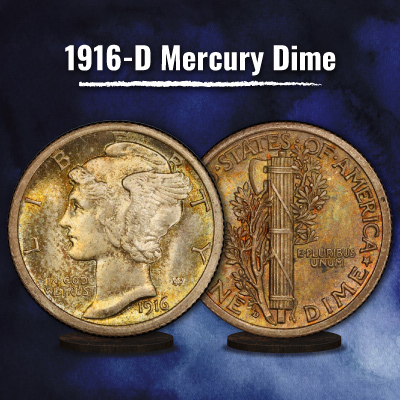
The 1916-D Mercury dime is widely known as a rare coin, much like the 1909-S VDB Lincoln cent. A mere 484,000 1916-D Mercury dimes were produced, and only a small portion of them remain, which is far from sufficient to satisfy collectors' needs.
Although finding a 1916-D Mercury dime in circulation is a dream for many, it has never been easy to find in pocket change. Purchasing one from a coin dealer is the most effective way to obtain one. The 1916-D's high visibility as a rarity and limited supply drives up the coin's value.
In low-circulated grades, it typically trades for approximately $1,000. Higher-quality specimens fetch higher prices; examples in Extremely Fine-40 go for about $5,500. Complete Bands on uncirculated examples can fetch over $10,000.
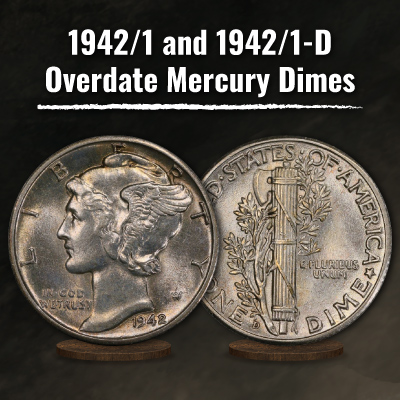
The 1942/1941 overdated Mercury dime is among the most valuable ones that you may still find in your pocket. Some 1942 dime examples were struck in the Denver mint using both the 1941 and 1942 dies during World War II.
It is most likely worth a few hundred dollars, but if you find one, it might be worth much more. In 2016, a nearly perfect example brought $25,850 at auction.
To find evidence of the overstrike, you will have to carefully review the date.
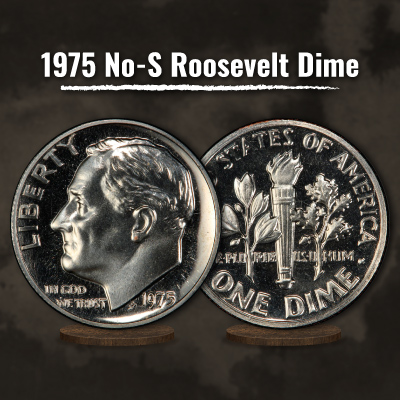
The way proof dies were handled led to the creation of "No-S" coins, or proof coins without mint marks.
The Philadelphia Mint prepared the dies for the Proof coins, which the San Francisco Mint began producing in 1968.
The procedure was affixing a mintmark to standard Philadelphia dies. Some deaths, though, were able to elude this procedure, which is how "No-S" coins came to be.
One of these coins sold for $456,000 in 2019, according to PCGS.
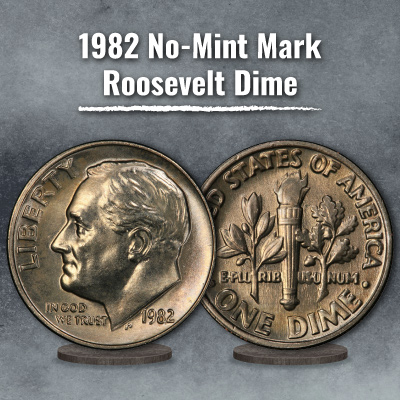
The no-mintmark dime from 1982 is a very rare variety.
Tens of thousands, at most, were struck; that is, a negligible portion of the 519.4 million Roosevelt dimes the Philadelphia Mint produced in 1982.
In typical uncirculated grades, a 1982 no-mintmark dime with a weak strike is valued at approximately $55. Stronger strikers are valued at about $175 and higher.
What would you do if you had recently discovered some valuable dimes and were looking to sell them or if you intended to sell your collection of dimes for cash?
Well, it's not too complicated.
The American Numismatic Association recommends that buyers and sellers obtain appraisals from certified ANA dealers. A thorough evaluation would assist you in maintaining fair prices and preventing lowballing. Don't offer less once you've decided on a price.
Furthermore, not all pennies that you may find around the house have a higher value than their face value. Perhaps you're sitting on a valuable quarter, penny, or half-dollar.
Valuable dimes and other forms of currency can be easily sold through online platforms without much hassle. Your valuable coin collection should receive nothing less than the highest possible price.
To sum up, how much is a dime worth? A dime is worth much more than its nominal value of ten cents.
For collectors, dimes can be quite valuable, regardless of whether they are rare error coins or silver dimes. Dating back before 1965. Finding valuable dimes is an exciting adventure that involves more than just assessing their monetary worth—it's also about finding hidden treasures.
The world of dime values can be fascinating and rewarding to explore, whether you're an experienced collector or just getting started.
Thus, the next time you find a dime, examine it more closely because you might be holding something more than just spare change.
Information and Image Source: PCGS, NGC and Heritage Auctions.Find more insights on precious metals and rare coins in our BOLD Precious MetalsBlog section.





















